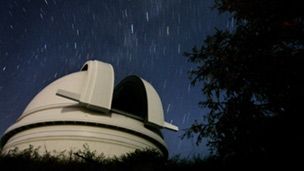美国宇航局“新视野号”飞掠冥王星
Nasa spacecraft speeds past Pluto
美国宇航局“新视野号”飞掠冥王星
 美国宇航局“新视野号”飞掠冥王星
美国宇航局“新视野号”飞掠冥王星美国宇航局的“新视野号”探测器与冥王星成功相遇。“新视野号”探测器本周二(7月14日)以每秒十四公里的速度飞过冥王星。科学家称“新视野号”收集的资料信息将改变人类对距离太阳最远的太阳系行星的认识。请听 Jonathan Amos 的报道。
For those of us who grew up with the idea that there were nine planets, this is the moment we get to complete the set. Robotic probes have been to all the others - even the distant Uranus and Neptune. Pluto is the last of the familiar nine to get a visit。
Of course, it was demoted to dwarf status in 2006, but this doesn't seem to have dulled anyone's enthusiasm. The New Horizons probe will sweep by at high speed, grabbing as many pictures and other types of science data as it can. Not just of Pluto but also its five moons: Charon, Styx, Nix, Kerberos and Hydra。
Unfortunately, the vast distance from Earth makes for very weak radio signals, and it's going to take many months to get all the images back. Nonetheless, the lead researcher, Alan Stern, says we should be prepared for some remarkable discoveries…
Alan Stern, NASA lead researcher
I like to say that this is in a sense, a return to the kind of space exploration in the sixties and seventies, when everything was completely new - first mission to Venus, first mission to Mars, first mission to everywhere. And although new missions, for example to the surface of Mars, teach us tremendous amounts, where people say we re-write the textbook. This is an example of not re-writing the textbook - we're gonna write the textbook。
Media English ©British Broadcasting Corporation 2015
bbcukchina.com/learningenglish Page 2 of 3
词汇表
complete the set
(此处指)证明太阳系确实有九大行星
robotic probes
机器探测器
familiar
熟知的
demoted
被降级
dwarf status
矮(星)级别
dulled
使降低、失去兴趣
grabbing
抓取
vast
巨大的
remarkable
不同寻常的,非凡的
in a sense
从某种程度上,从某种意义上讲
mission
任务
tremendous
极多的,惊人的
测验
请听报道并回答下列问题。
1. Before its visit to Pluto, how many planets did the robotic probe visit?
2. Why will the robotic probe send back very weak signals?
3. When did early space exploration take place?
4. True or false? NASA lead researcher, Alan Stern, says he will be using a textbook to understand what the images mean。
Media English ©British Broadcasting Corporation 2015
bbcukchina.com/learningenglish Page 3 of 3
答案
1. Before its visit to Pluto, how many planets did the robotic probe visit? Answer: Eight. Pluto is the last of the familiar nine to get a visit。
2. Why will the robotic probe send back very weak signals? Answer: Because of the vast distance from Earth。
3. When did early space exploration take place? Answer: In the 1960s and 1970s。
4. True or false? NASA lead researcher, Alan Stern, says he will be using a textbook to understand what the images mean. Answer: False. He said "This is an example of not re-writing the textbook - we're gonna write the textbook."
 BBC英语学习
BBC英语学习

